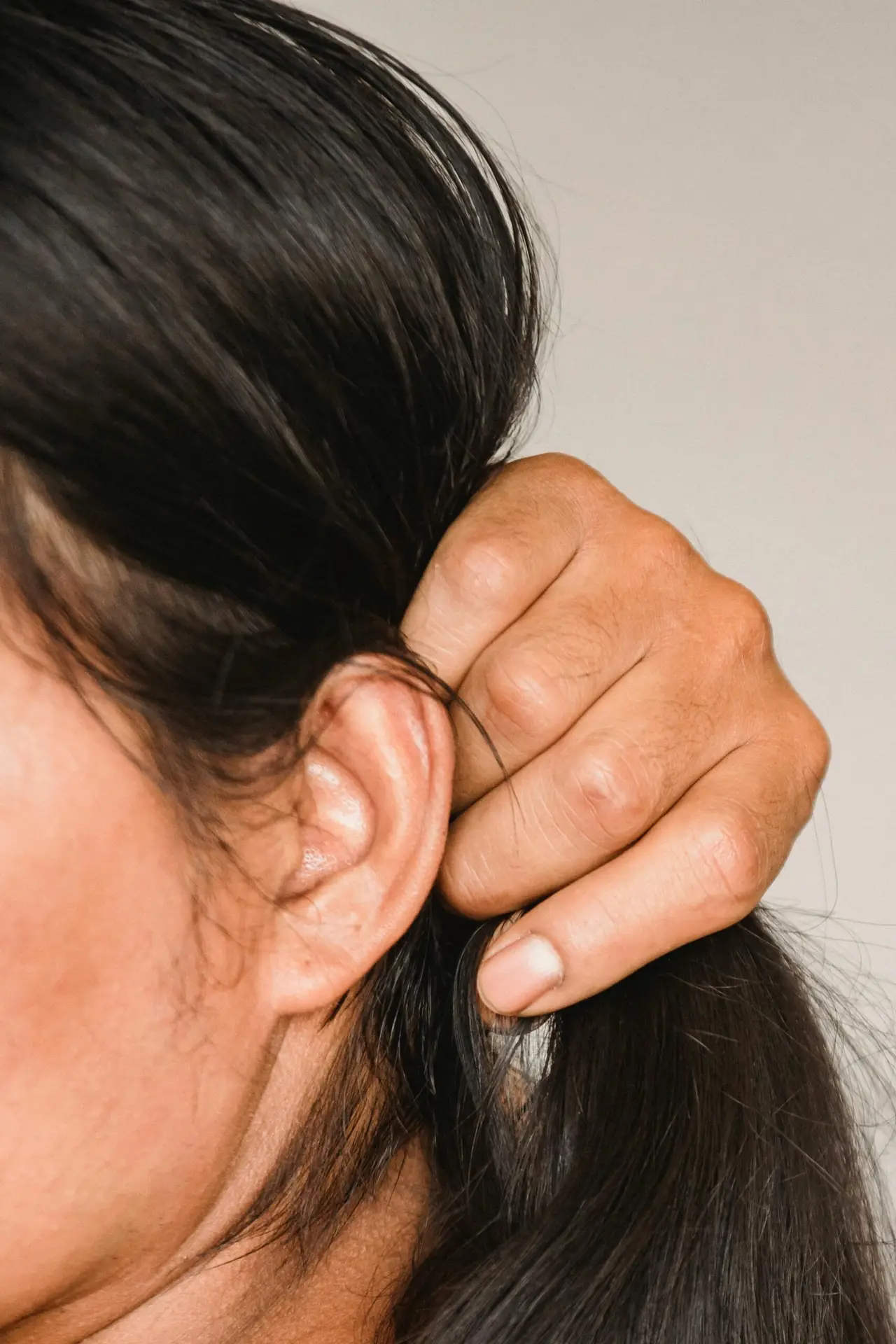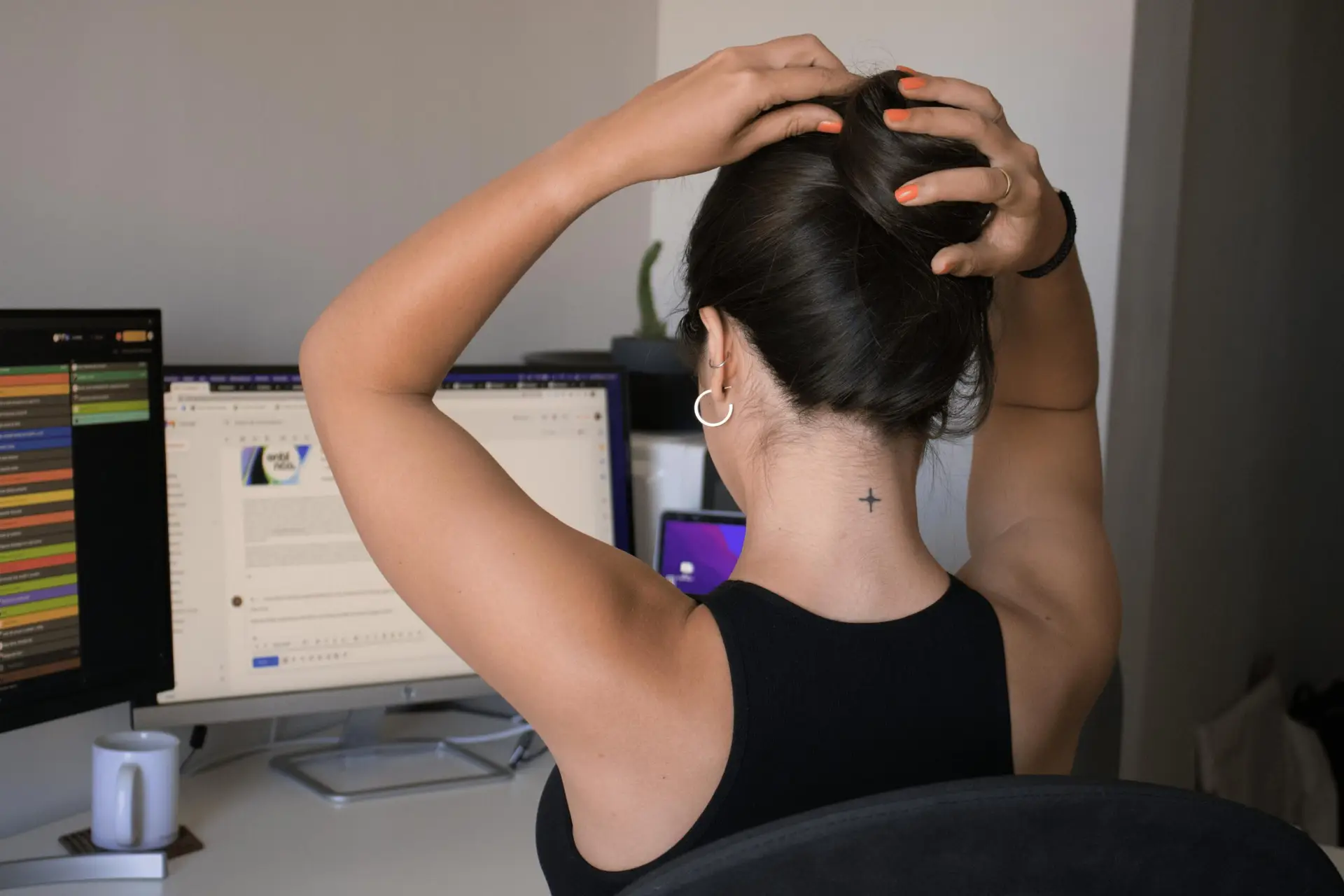
Why do my ears feel full? Feeling like your ears are clogged, underwater, or waiting to “pop” can turn an ordinary day into a constant distraction. For many people across Sarasota, Bradenton, Lakewood Ranch, and the surrounding Gulf Coast, ear fullness shows up alongside clicking, crackling, popping, muffled hearing, head pressure, dizziness, or even vertigo—then flares again with every Florida storm or airplane ride. If you’ve cycled through decongestants, antibiotics, nasal sprays, and even ENT procedures without lasting relief, take heart: you’re not broken, and you’re not stuck this way.
At Lavender Family Chiropractic in Sarasota, we take a precise, gentle approach that asks a different question: Why is your system struggling to equalize ear pressure in the first place? Very often the answer lives in a delicate, powerful area at the top of the neck—the upper cervical spine (atlas C1 and axis C2)—and its relationship to your Eustachian tubes, cranial nerves, and the way your body adapts to barometric pressure. This comprehensive guide explains what’s really happening, why Florida weather makes it worse, and how upper cervical chiropractic can help you feel clear, calm, and steady again—without twisting, popping, or cracking the neck.
Why Do My Ears Feel Full? Ear Fullness 101: What That “Clogged” Feeling Is Trying to Tell You
Ear fullness—sometimes called aural fullness—is the sensation that the middle ear can’t equalize pressure with the environment. People describe it as cotton in the ears, a “stuck” eardrum, or the trapped pressure you feel during takeoff and landing that simply won’t release. Common companions include:
- Clicking, crackling, or popping (especially with swallowing or yawning)
- Muffled hearing or fluctuating sound clarity
- Head pressure or sinus pressure, sometimes behind the eyes or temples
- Dizziness, imbalance, or vertigo episodes
- Tinnitus (ringing, buzzing, hissing)
- Sensitivity to weather changes or altitude shifts
Yes, earwax or acute infection can cause short-term fullness. But when symptoms linger for weeks or cycle with storms, flights, or stress, the more likely culprit is Eustachian Tube Dysfunction (ETD)—often with a hidden upper cervical component that standard treatments overlook.
Your Eustachian Tube: The Ear’s Pressure Valve (and Drainage Gate)
Each ear has a narrow, flexible tunnel—the Eustachian tube—that connects the middle ear to the back of your nose and upper throat (nasopharynx). Its jobs:
- Equalize air pressure on both sides of the eardrum so it can vibrate freely.
- Drain fluid from the middle ear into the throat.
- Protect the middle ear from nasopharyngeal secretions and pathogens.
The tube should open for a split second whenever you swallow, yawn, or chew, thanks to small muscles—primarily the tensor veli palatini and levator veli palatini. When the tube doesn’t open often enough, doesn’t open fully, or stays sticky from inflammation, pressure builds and you feel that characteristic fullness and popping.
Eustachian Tube Dysfunction (ETD): When the Valve Stops Behaving
ETD is an umbrella term for problems with the tube’s opening/closing mechanics. There are two common patterns:
- Obstructive ETD: The tube doesn’t open well (inflammation, swelling, muscular discoordination). Symptoms: fullness, popping, muffled hearing, pressure with weather/altitude.
- Patulous ETD: The tube stays too open; some people hear their own breathing or voice loudly (autophony). Less common, but still about misregulated muscle tone.
Contributors to ETD include allergies, sinus congestion, recent respiratory infections, structural issues (deviated septum, enlarged adenoids), and—crucially—neuromuscular control from the brainstem and cranial nerves that can be influenced by the upper cervical spine.
Why Barometric Pressure (and Florida Weather) Makes Ear Fullness Worse
Barometric pressure is the weight of the air around you. Before a storm or weather front, pressure typically drops. That external change means your ears must quickly equalize internal pressure via the Eustachian tube. If the tube is inflamed or poorly coordinated, the middle ear can’t keep up and your eardrum gets “stuck” against a pressure mismatch. Cue fullness, popping, head pressure, and sometimes dizziness.
On the Gulf Coast—Sarasota, Bradenton, Lakewood Ranch, Siesta Key, Longboat Key, Lido Key—these swings can arrive weekly. People often say, “My ears predict the storms.” When we restore neurological control and mechanical balance in the upper neck, their system adapts more gracefully to the same environmental changes.
The Upper Cervical Connection: How Your Neck Talks to Your Ears
The top of the neck—atlas (C1) and axis (C2)—surrounds the lower brainstem, where crucial cranial nerve pathways travel. Even a slight misalignment can change neural signaling, muscle tone, and fluid dynamics in the head/neck region. This matters for your ears because:
- The tensor veli palatini and levator veli palatini muscles open the Eustachian tube. Their coordination is influenced by cranial nerves that emerge or relay near the brainstem.
- The glossopharyngeal (CN IX) and vagus (CN X) help regulate swallowing and parasympathetic tone; imbalance can alter the timing/efficiency of Eustachian opening.
- The trigeminal (CN V) supplies sensation across the face and parts of the ear; irritation can create referred ear pain/pressure.
- The upper cervical region affects venous and lymphatic drainage and cerebrospinal fluid (CSF) flow; congestion elevates head/ear pressure and sensitivity.
- Autonomic nervous system balance (sympathetic/parasympathetic) influences inflammation, vascular tone, and tissue reactivity—key for weather responses.
When the atlas or axis is off, you can get a “perfect storm”: sticky tubes, poor equalization, amplified barometric sensitivity, and a vestibular system on edge. Correct the alignment, and the system can recalibrate.
Common Clues Your Ear Fullness Has an Upper Cervical Component
- Fullness/popping that cycles with storms or airplane travel
- Ear symptoms that began after a whiplash, concussion, or neck strain
- Neck pain or stiffness alongside ear complaints
- Dizziness, vertigo, or motion sensitivity, especially with head turns
- Headaches, facial pressure, or TMJ tension
- ENT work-up is clear, but symptoms persist or recur
None of these prove causation by themselves. Together, they strongly suggest the ear–neck–nervous system loop needs to be tested—not just the ear alone.
How Lavender Family Chiropractic Finds (and Fixes) the Root Cause
At Lavender Family Chiropractic in Sarasota, our doctors—Dr. Rusty Lavender, Dr. Jacob Temple, and Dr. Will Guzinski—focus exclusively on the upper cervical spine. Our process is data-driven, gentle, and tailored to your anatomy.
Step 1: Detailed Consultation and Functional History
We map when your fullness began, what worsens it (storms, flights, exercise), what helps (hydration, certain positions), and what coexists (migraines, sinus issues, TMJ, concussion history).
Step 2: 3D CBCT Imaging
We use state-of-the-art 3D CBCT scans to visualize the atlas/axis with exquisite detail. This lets us measure exact misalignment vectors—rotations, tilts, and slips—that standard X-rays can miss.
Step 3: Tytron Paraspinal Infrared Thermography
With Tytron scans, we evaluate autonomic nervous system patterns along the spine. As alignment normalizes, these patterns often stabilize, confirming improved neural regulation—key for Eustachian mechanics.
Step 4: Posture, Balance, and Neurologic Tests
We evaluate head carriage, cervical range of motion, proprioception, vestibulo-ocular coordination, and symptom reproduction to understand real-world function, not just static pictures.
Step 5: Gentle, Precise Upper Cervical Corrections
No twisting. No popping. No cracking. We deliver a specific, light-force correction based on your CBCT measurements to restore a neutral relationship between your skull and C1/C2. This reduces brainstem irritation and helps normalize muscle tone, fluid dynamics, and autonomic balance.
Step 6: Stabilization and Progress Tracking
We want your body to hold the correction, not rely on constant adjustments. We track changes in symptoms, posture, and Tytron scans as your system becomes more resilient—to weather, travel, and daily life.
What Improvement Looks Like (and Why “Holding” Matters)
In the early phase, people often report:
- Spontaneous ear “pops” during the day that used to be impossible
- Less intense pressure with storms or altitude changes
- Clearer hearing and fewer muffled episodes
- Reduced head pressure, tinnitus intensity, or sound sensitivity
- Better balance and less “foggy” headspace
Over time, as corrections hold longer, the Eustachian tube behaves more like a well-oiled valve again—opening rhythmically without drama. Symptoms occur less often, with less intensity, and recovery is faster.
Four Sarasota Stories (De-Identified) That Mirror What We See Every Week
1) The Storm Forecaster
A 37-year-old teacher “felt” every front two days early—tight ears, face pressure, and a dull headache. ENT findings were normal. CBCT revealed an atlas tilt and rotation. Within a few weeks of upper cervical care, she still noticed weather patterns—but without the pressure cascade. She keeps a light maintenance schedule during hurricane season and enjoys a calm head again.
2) The Frequent Flyer
A 52-year-old consultant dreaded flights; his ears wouldn’t equalize and he’d land with throbbing head pressure. After targeted atlas corrections, he reported mid-flight clearing with casual swallowing—no forceful Valsalva—and no post-flight headaches.
3) The Post-Infection Spiral
A 28-year-old parent had a winter sinus infection; the infection cleared but fullness, crackling, and positional dizziness lingered for months. Imaging showed atlas rotation with head-tilt. As alignment stabilized, her Eustachian function normalized—she tossed the decongestant pack she carried everywhere.
4) The Migraine + Ear Pressure Duo
A 45-year-old with vestibular migraines tracked flares with storms and hormones. After stabilizing her upper cervical spine, she had fewer dizzy days, lighter ear pressure, and a dramatic reduction in migraine frequency.
(Every case is unique, but these patterns are common in our office.)
When You Still Need an ENT (and When It’s Urgent)
Upper cervical care works best alongside appropriate medical care. Seek urgent evaluation if you have:
- Severe ear pain with fever, redness or swelling behind the ear
- Sudden hearing loss, bloody or purulent drainage, or a high fever
- Neurologic red flags (facial droop, slurred speech, a “worst-ever” headache)
We regularly co-manage with ENTs and primary care—especially in complex cases—so you get structural, neurologic, and medical support working together.
Home Strategies That Support Your Ears While You Heal
- Hydrate well to support pressure regulation and mucus viscosity.
- Use gentle swallow/yawn cycles through the day; avoid overly forceful Valsalva.
- Elevate your head slightly at night to encourage drainage.
- Practice posture hygiene: screens at eye level, frequent position changes, avoid long bouts of forward head posture.
- Allergy management (as advised by your provider) to reduce inflammatory load on the tube.
- Flight prep: sip water during ascent/descent; consider filtered earplugs designed for pressure changes.
- Walk and breathe: light movement and diaphragmatic breathing support autonomic balance and lymphatic flow.
These steps aren’t meant to replace care; they amplify the benefits as your upper neck and nervous system settle.
Why Choose Lavender Family Chiropractic (Sarasota, FL)
- Exclusive Focus on Upper Cervical Chiropractic (atlas/axis, C1/C2)
- 3D CBCT imaging for pinpoint planning
- Tytron paraspinal thermography to track autonomic changes
- Gentle, no-twist corrections, customized to your anatomy
- A 3-doctor team—Dr. Rusty Lavender, Dr. Jacob Temple, Dr. Will Guzinski—who collaborate on complex cases
- Patients travel from Sarasota, Bradenton, Lakewood Ranch, Parrish, Ellenton, Venice, Osprey, Punta Gorda, St. Petersburg, Siesta Key, Longboat Key, Lido Key, and Myakka City
If you’re searching for “chiropractor Sarasota Florida,” “chiropractor near me,” “upper cervical chiropractor near me,” “upper cervical chiropractic,” “Vertigo doctor near me,” or “Migraine doctor near me,” you’ve found a team that focuses on the cause rather than chasing symptoms.
Top 15 FAQs About Ear Fullness, ETD, Barometric Pressure, and Upper Cervical Chiropractic
1) Why do my ears feel full if nothing is “wrong” on my ENT exam?
Because function can fail before structure looks abnormal. ETD often stems from poor opening/closing timing and muscle control. Upper cervical misalignment can irritate brainstem pathways that coordinate the tube, so the valve simply doesn’t behave—especially with weather shifts.
2) What causes the clicking and popping I hear when I swallow?
That’s the Eustachian tube attempting to open. If muscles are poorly coordinated or the tube is sticky from inflammation, you’ll get frequent pops or partial releases without satisfying pressure equalization.
3) Why are my symptoms worse before storms or on planes?
Barometric pressure changes demand quick equalization. A sluggish tube or a nervous system stuck in “fight-or-flight” can’t adapt fast enough, so the eardrum is pulled off neutral and you feel fullness, pressure, and sometimes dizziness.
4) How does upper cervical chiropractic help ETD?
By gently correcting atlas/axis alignment, we reduce brainstem irritation, normalize autonomic tone, improve muscle coordination for tube opening, and support venous/lymphatic drainage. Many patients report their ears finally “pop” on their own again.
5) Is the adjustment safe? Do you twist or crack the neck?
Our approach is gentle and precise—no twisting, popping, or cracking. Corrections are tailored from 3D CBCT measurements and delivered with light force.
6) What testing do you use to know it’s working?
We combine 3D CBCT imaging, Tytron thermography, posture and neurologic checks, and your clinical progress. Tytron patterns often calm as nervous system irritation decreases.
7) Will I feel relief right away?
Some people notice immediate pressure changes or easier popping. Others improve steadily as corrections hold and tissues recalibrate. We track objective and subjective progress together.
8) Can this help tinnitus too?
While tinnitus has multiple causes, many patients report reduced intensity/frequency as pressure regulation, drainage, and neural tone improve.
9) Do you work with kids or seniors?
Yes. Our corrections are very gentle and appropriate for all ages—including children with recurrent ear issues and older adults with posture-related ETD.
10) I’ve tried decongestants, nasal sprays, and antibiotics. Why didn’t they last?
They can reduce inflammation temporarily, but if the underlying neuromuscular control and upper cervical mechanics aren’t addressed, symptoms can return with the next storm, flight, or stressful week.
11) How many visits will I need?
It varies based on the complexity and duration of your misalignment, stress load, and healing capacity. Our goal is to help you hold corrections longer and space visits appropriately as stability increases.
12) Do you take insurance?
Our office is out of network with insurance. Many of our patients receive a superbill to submit to their insurance for reimbursement based on their coverage. We offer many different payment options as well as finance options.
13) Can I continue ENT care while seeing you?
Absolutely. Upper cervical care complements ENT and primary care. We co-manage when appropriate and refer promptly if we see medical red flags.
14) Will barometric sensitivity ever go away?
Many patients become far less reactive once the tube opens reliably and the neck is stable. Weather still changes; your response becomes calmer and recovery faster.
15) Why choose Lavender Family Chiropractic if I live in Bradenton or Lakewood Ranch?
People travel because we combine advanced imaging, gentle precision, and focused expertise in upper cervical care—with a track record of helping those who’ve “tried everything” finally get results.
A Deeper Look: Upper Cervical Alignment, CSF, and Vascular Flow
Beyond muscle timing, the upper neck influences cerebrospinal fluid (CSF) movement, venous return, and lymphatic drainage. When the atlas is misaligned, subtle bottlenecks can form at gateways where fluid is supposed to circulate freely. The result can feel like head pressure, ear pressure, and brain fog. Correcting C1/C2 mechanics helps restore smooth fluid dynamics, making barometric shifts feel less like a tidal wave and more like a small, manageable ripple.
Myths vs. Facts About Ear Fullness and ETD
Myth: “If antibiotics didn’t help, nothing will.”
Fact: Many chronic cases are not infections. They’re functional problems—tube opening, neural tone, posture, or drainage.
Myth: “If my ears won’t pop, I just need to blow harder.”
Fact: Overly forceful Valsalva can irritate tissues. Gentle, frequent swallowing/yawning is safer. Fixing the cause is smarter.
Myth: “If the ENT doesn’t see fluid, it’s all in my head.”
Fact: Functional timing problems and neurological dysregulation can exist without visible fluid. Your symptoms are real—and solvable.
Myth: “Chiropractic is all twisting and cracking.”
Fact: Upper cervical care is precise and gentle. We use 3D CBCT and Tytron to guide light-force corrections that many patients find surprisingly relaxing.
Who We Help (and Where We Serve)
We routinely see people with ear fullness, ETD, barometric pressure sensitivity, dizziness/vertigo, vestibular migraine, head pressure, TMJ tension, neck pain, and post-concussion issues who haven’t found lasting relief elsewhere. Our patients come from:
Sarasota, Bradenton, Lakewood Ranch, Parrish, Ellenton, Venice, Osprey, Punta Gorda, St. Petersburg, Siesta Key, Longboat Key, Lido Key, and Myakka City.
If you’re searching for “chiropractor Sarasota Florida,” “chiropractor near me,” “upper cervical chiropractor near me,” “upper cervical chiropractic,” “Vertigo doctor near me,” or “Migraine doctor near me,” we’re here to help.
Your Next Step: A Calmer, Clearer Way to Live
You shouldn’t have to schedule life around storms, flights, or ear drops. If you’re ready to address the root cause of ear fullness instead of chasing symptoms, we’re ready to listen, measure, and help you heal.
At Lavender Family Chiropractic, we combine 3D CBCT imaging, Tytron functional nervous system scans, and gentle, precise upper cervical corrections to help your body equalize pressure naturally, adapt to barometric changes, and feel steady again.
Lavender Family Chiropractic in Sarasota Florida offers complimentary consultations to learn more about you. Click the link below!
https://intake.chirohd.com/new-patient-scheduling/724/lavender-family-chiropractic
Visit our Website!
To learn more about us go to http://www.chiropractorsarasotaflorida.com
We also service Bradenton, Parrish, Ellenton, Ruskin, Venice, Tampa, St. Pete, Osprey, Longboat, Lakewood Ranch, Myakka City.
If you are in Tampa, Fort Myers, or Salt Lake City, you can visit my other locations! NeckWise Upper Cervical. Visit, www.neckwise.com
If you are not local, visit www.uccnearme.com to find a doctor in your area.
Call us today at (941) 243-3729 or visit www.chiropractorsarasotaflorida.com to request your consultation. Hope—and clarity—are closer than you think.
Lavender Family Chiropractic
5899 Whitfield Ave Ste 107, Sarasota, FL 34243
📞 (941) 243-3729
🌐 www.chiropractorsarasotaflorida.com
Instagram: @lavenderfamilysrq
TikTok: @drrustylavender



